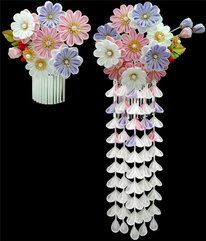Hello beautiful!!! Glad to see you!!!
Well…since a lot of my flowers are made in style of KANZASHI, I decided to post a little bit of educational material on The Origin of this style.
So??? Let’s get this ball rolling )))
Well…since a lot of my flowers are made in style of KANZASHI, I decided to post a little bit of educational material on The Origin of this style.
So??? Let’s get this ball rolling )))

Kanzashi are hair ornaments used in traditional Japanese hairstyles (this how this word look likes in Japanese 簪).
Kanzashi were first used in Japan during the Jōmon period. During that time, a single thin rod or stick was considered to have mystical powers which could ward off evil spirits, so people would wear them in their hair.
During the Nara period, the influence of Chinese culture reflected in the design of fashion items, ornaments and kanzashi.
During the Heian period, the traditional style of putting hair up was changed to wearing it long, tied back, and down. It was at this time that kanzashi began to be used as a general term for any hair ornament, including combs and hairpins.
During the Azuchi-Momoyama period, the hairstyles changed from the taregami or long straight hair, to the wider variety of "Japanese hair" which makes more use of hair ornaments.
During the middle part of the Edo period hairstyles became more complicated and large, using a larger number of ornaments. During the latter part of the Edo period, the craftsmanship of kanzashi reached a high point, with many different styles and designs being created.
During the Nara period, the influence of Chinese culture reflected in the design of fashion items, ornaments and kanzashi.
During the Heian period, the traditional style of putting hair up was changed to wearing it long, tied back, and down. It was at this time that kanzashi began to be used as a general term for any hair ornament, including combs and hairpins.
During the Azuchi-Momoyama period, the hairstyles changed from the taregami or long straight hair, to the wider variety of "Japanese hair" which makes more use of hair ornaments.
During the middle part of the Edo period hairstyles became more complicated and large, using a larger number of ornaments. During the latter part of the Edo period, the craftsmanship of kanzashi reached a high point, with many different styles and designs being created.
There are several basic kanzashi styles, along with more complex hana (flower) and seasonal arrangements as well.
We’ll focus on HANA KANZASHI, since I am creating flowers and this is actually the whole point of my post today. But if you are interested in learning about all the types of kanzashi check out Wikipedia.
Hana kanzashi, the long fluttering flowers are created by Japanese artisans from squares of hobotai silk by a technique known as tsumami. Tiny (usually 1") squares of silk are folded into petals using origami techniques. Tsumami consists of two types of methods called maru-tsumami (round pinching) and kaku/ken-tsumami (sword-shaped pinching).
We’ll focus on HANA KANZASHI, since I am creating flowers and this is actually the whole point of my post today. But if you are interested in learning about all the types of kanzashi check out Wikipedia.
Hana kanzashi, the long fluttering flowers are created by Japanese artisans from squares of hobotai silk by a technique known as tsumami. Tiny (usually 1") squares of silk are folded into petals using origami techniques. Tsumami consists of two types of methods called maru-tsumami (round pinching) and kaku/ken-tsumami (sword-shaped pinching).
Flowers that are made from these folded fabric petals may contain anywhere from five petals to 75 or more, depending on the particular flower made. They are attached to backings of metal to create whole flowers, or attached to silken threads to create strings of blossom. Butterflies and birds are also common in this art form.

Today, tsumami kanzashi is worn by maiko, the young girls who are training to become geiko (also known as a geisha). In their custom, kanzashi are seasonal and customized based on the month. For example, they wear plum blossoms in February, cherry blossoms in April, and wisteria or iris in May. Tsumami kanzashi is also worn for celebrating the New Year, coming-of-age ceremonies, weddings, and performing classical Japanese dance.
But it’s in Japan. How about you and me??? Well…many modern versions of these delicate flowers are created with a wide range of fabrics. As for me, I like to use satin ribbon and recently discovered that grosgrain ribbon is also looks really good (check out the Gallery of my works). And unlike the Japanese, we use kanzashi for items other than hair including shirts, necklaces, earrings, purses and more.
Well...I hope you liked this post and I’ll see you later.
Well...I hope you liked this post and I’ll see you later.




 RSS Feed
RSS Feed